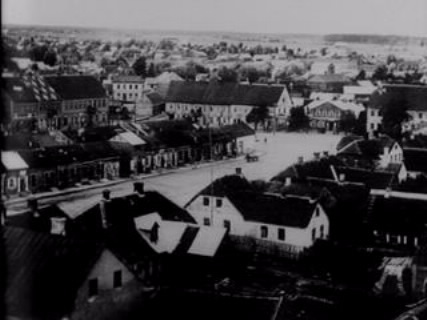Historic Events

The Jewish Community in Žagarė was, of course, affected by historic events. Zhager residents suffered many adversities including the Russian-Swedish war in 1705 and a cholera epidemic in 1848. The great fires of 1864 and 1881 severely affected the Jewish economy. In 1881, 400 structures were destroyed, including three stores, the synagogue and beit midrash (house of study), and a community building. There were also fires in 1909 and 1911; in one post-1900 fire almost all of Old Zhager was destroyed by fire.
The Jews were active in the revolutionary movement of 1905 when Žagarė was briefly proclaimed an autonomous republic. A Jewish woman embroidered the Žagarė Republic flag. When the Russian authorities put down the revolt, Jewish as well as gentile participants were severely punished. The Cossacks were sent by the government to punish the rebels through beating, whipping, and arson. Once they locked all the Jewish men in the synagogue and held them for two days, demanding they give up the locations of the revolutionaries. For a large sum, the Jews were freed.
At the beginning of World War I all the Jews of Žagarė were sent into exile deep into Russia. Many of the town's Jewish inhabitants did not return from their exile. Many of those who came back soon emigrated to the United States, South Africa, or Palestine.
During the period of Lithuanian independence (1918-1940) economic activity in Žagarė declined steeply and it never regained its former vigor. The population dwindled to what it had been 60 years previously. After World War I, the newly drawn border between the new independent states of Lithuania and Latvia left Žagarė as an isolated backwater, cut off from Russian and Latvian markets. Another factor that added to the region's economic depression was that the railway station nearest to Žagarė was 28 kilometers distant. And the main road to Žagarė was impassable in rainy weather.
According the a government survey in 1931 there were still twenty-five workshops and light industries owned by Jews, including boot makers, sawing workshops and a flour mill, bakery, sawmill, dying plant, and power plant. In 1937 there were fifty-five Jewish artisans including boot makers, tailors, butchers, dressmakers, tinsmiths, bakers, and barbers. However the 1930's saw many Jewish merchants and youth move from Žagarė due to competition from Lithuania cooperatives, being cut off from Latvia, and general difficult economic conditions.
Introduction
History
- History by compiler
- - Historic Events
- - Emigration & Extermination
- - Noteworthy Natives & Descendants
- - References
- Others' Histories
- Rose Zwi's story
- Historic photographs

